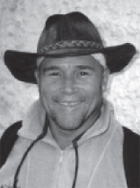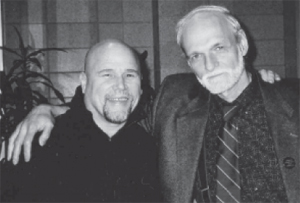By John Harrison, Psy.D.

John Harrison
maps • volume xvi number 2 • Autumn 2006
The skies were a slippery gray and the air was wintry cold on the February weekend of the 2006 NYC Ibogaine Conference. The chilly weather, though, did not in any way inhibit the fervent and passionate panel discussions and genuine warm vibes that permeated the gathering.
I am currently preparing a program evaluation protocol for ibogaine treatment clinics in Canada (Iboga Therapy House) and Mexico (Villa Serena) for my dissertation at the California Institute for Integral Studies (CIIS). As a witness to the healing potential of ibogaine, I have sought to work with providers to help them better analyze the variables that affect the long-term outcome of ibogaine treatment.
Thus, I was delighted to be immersed in the diverse and colorful assembly of journalists, researchers, street providers, neurologists, psychologists, physicians, activists, artists and successful veterans of ibogaine treatment that joined me at the conference. The positive energy was palpable and as the conference unfolded, the various presenters articulated the breadth of interest in this little root from the Tabernather iboga plant from West Africa. MAPS members and Bulletin readers are most likely familiar with the potential of ibogaine to reduce drug craving and its concomitant symptoms, and the political and financial obstacles hindering its accessibility.
Jeffrey Kamlet, M.D., (ibogaine treatment provider) and Patrick Kroupa (ibogaine activist and founder of Mindvox) opened the proceedings with a crash course in Ibogaine 101. Dr. Kamlet, who is currently President of the Florida Society for Addiction Medicine, impressed mightily with his unimpeachable medical expertise. Jeff spoke in depth about safety, particularly emphasizing medical prescreening prior to ibogaine administration. Patrick Kroupa captivated the crowd with his unfaltering integrity and honest self-disclosure regarding his own tortuous process through addiction. Declaring “ibogaine is a gift,” Kroupa also reiterated that “ibogaine is more than detox; it’s a catalyst, not a cure.” Patrick’s street credibility and his insight into the human toll of addiction was a poignant and profound balance to Dr. Kamlet’s clinical knowledge. Truly a formidable tandem of truth from two who have been in “the belly of the beast!”
Medical journalist Brian Vastag discussed the circuitous route of ibogaine’s “forty years of flirtation with legitimacy” as a viable treatment protocol for heroin addiction.
Kenneth Alper, M.D., (NYU Associate Professor of Psychiatry and Neurology) presented a sweeping discourse on ibogaine’s mechanisms of action on the human brain. Dr. Alper presented a sampling of his scientific research while making the case for clinical trials in the U.S. Ken managed to convey challenging, complex, and important data in straightforward language that both the novices and the experts in the audience could comprehend.
Introduced as special visitors to the conference were physicians and treatment providers Drs. Alberto Sola and Adolfo Martinez from Villa Serena, an ibogaine treatment center in Cancun, Mexico. As activist Dana Beal opined, “supporting and legitimizing clinics in Canada and Mexico will have the effect of embarrassing the United States by saying ‘why everywhere else but not here?’”

John Harrison & Howard Lotsof
Howard Lotsof, the sagacious and insightful ‘Grandfather of ibogaine’ gave a comprehensive slide presentation on the history, politics, policy, profit, prejudice, and science of ibogaine. Lotsof, who first discovered ibogaine as a viable treatment for heroin addiction in 1962, reflected the tone of the gathering by emphasizing inclusiveness, and by celebrating the common goal of making this valuable medicine available to the people who would most benefit from safe and unencumbered access.
The opening day session culminated in an extraordinary and ssspirited political panel which included Dmitri Mugianis (ibogaine treatment provider and former patient), Lotsof, Douglas Greene and the peripatetic Dana Beal (Cures Not Wars). Saturday evenings reception featured the powerful documentary Ibogaine: Rite of Passage, by film-maker Ben de Loenen.
Then, on Sunday the conference shifted to the wonderful and inspiring environment of Alex Grey’s Chapel of Sacred Mirrors (COSM) on W. 27th Street. Grey’s vivid colors and breathtaking images provided appropriate and stimulating surroundings for topics and presentations that included “Ibogaine as a Source of Revelation” (an exploration of the spiritual dimension of ibogaine), and “Ibogaine for Self-Development,” featuring authors Lee Albert and Daniel Pinchbeck. Others included, “Ibogaine and the Ritual of the Bwiti,” “Iboga Visions,” (including a discussion of the Œoneirophrenic or dreamlike phase of an iboga session), and a fantastic “Unexplanation of Ibogaine and Sacred Art,” featuring the stunning and visionary work of artists Geerte Frenken, David Hunter, and of course the inimitable Alex Grey.
Though the opinions shared and discussed in NYC were hardly monolithic, the enthusiastic debate around the interface of health and politics and the occasionally sharp ontological deliberations seemed to foment what was already an unmistakable esprit de corps and camaraderie amongst the highly energized attendees.
As for myself, the weekend left me feeling honored and inspired to meet so many learned, sensitive, and committed people who, though the work they do is often solitary, found hope and encouragement in this encounter with so many likeminded and like-hearted individuals.
As Lee Albert said so eloquently as the conference came to a close, “we grow in the spirit or die in the body.




